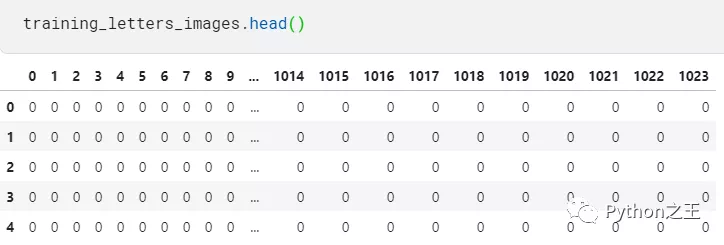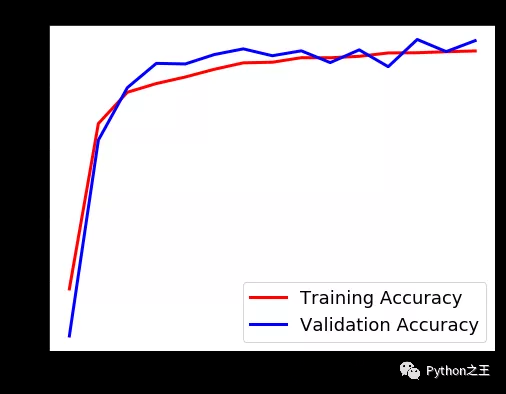在本教程中,我们将使用 TensorFlow (Keras API) 实现一个用于多分类任务的深度学习模型,该任务需要对阿拉伯语手写字符数据集进行识别。
数据集下载地址:https://www.kaggle.com/mloey1/ahcd1
数据集介绍
该数据集由 60 名参与者书写的16,800 个字符组成,年龄范围在 19 至 40 岁之间,90% 的参与者是右手。
每个参与者在两种形式上写下每个字符(从“alef”到“yeh”)十次,如图 7(a)和 7(b)所示。表格以 300 dpi 的分辨率扫描。使用 Matlab 2016a 自动分割每个块以确定每个块的坐标。该数据库分为两组:训练集(每类 13,440 个字符到 480 个图像)和测试集(每类 3,360 个字符到 120 个图像)。数据标签为1到28个类别。在这里,所有数据集都是CSV文件,表示图像像素值及其相应标签,并没有提供对应的图片数据。
导入模块
- import numpy as np
- import pandas as pd
- #允许对dataframe使用display()
- from IPython.display import display
- # 导入读取和处理图像所需的库
- import csv
- from PIL import Image
- from scipy.ndimage import rotate
读取数据
- # 训练数据images
- letters_training_images_file_path = "../input/ahcd1/csvTrainImages 13440x1024.csv"
- # 训练数据labels
- letters_training_labels_file_path = "../input/ahcd1/csvTrainLabel 13440x1.csv"
- # 测试数据images和labels
- letters_testing_images_file_path = "../input/ahcd1/csvTestImages 3360x1024.csv"
- letters_testing_labels_file_path = "../input/ahcd1/csvTestLabel 3360x1.csv"
- # 加载数据
- training_letters_images = pd.read_csv(letters_training_images_file_path, header=None)
- training_letters_labels = pd.read_csv(letters_training_labels_file_path, header=None)
- testing_letters_images = pd.read_csv(letters_testing_images_file_path, header=None)
- testing_letters_labels = pd.read_csv(letters_testing_labels_file_path, header=None)
- print("%d个32x32像素的训练阿拉伯字母图像。" %training_letters_images.shape[0])
- print("%d个32x32像素的测试阿拉伯字母图像。" %testing_letters_images.shape[0])
- training_letters_images.head()
13440个32x32像素的训练阿拉伯字母图像。3360个32x32像素的测试阿拉伯字母图像。
查看训练数据的head
- np.unique(training_letters_labels)
- array([ 1, 2, 3, 4, 5, 6, 7, 8, 9, 10, 11, 12, 13, 14, 15, 16, 17,18, 19, 20, 21, 22, 23, 24, 25, 26, 27, 28], dtype=int32)
下面需要将csv值转换为图像,我们希望展示对应图像的像素值图像。
- def convert_values_to_image(image_values, display=False):
- image_array = np.asarray(image_values)
- image_array = image_array.reshape(32,32).astype('uint8')
- # 原始数据集被反射,因此我们将使用np.flip翻转它,然后通过rotate旋转,以获得更好的图像。
- image_array = np.flip(image_array, 0)
- image_array = rotate(image_array, -90)
- new_image = Image.fromarray(image_array)
- if display == True:
- new_image.show()
- return new_image
- convert_values_to_image(training_letters_images.loc[0], True)
这是一个字母f。
下面,我们将进行数据预处理,主要进行图像标准化,我们通过将图像中的每个像素除以255来重新缩放图像,标准化到[0,1]
- training_letters_images_scaled = training_letters_images.values.astype('float32')/255
- training_letters_labels = training_letters_labels.values.astype('int32')
- testing_letters_images_scaled = testing_letters_images.values.astype('float32')/255
- testing_letters_labels = testing_letters_labels.values.astype('int32')
- print("Training images of letters after scaling")
- print(training_letters_images_scaled.shape)
- training_letters_images_scaled[0:5]
输出如下
- Training images of letters after scaling
- (13440, 1024)
从标签csv文件我们可以看到,这是一个多类分类问题。下一步需要进行分类标签编码,建议将类别向量转换为矩阵类型。
输出形式如下:将1到28,变成0到27类别。从“alef”到“yeh”的字母有0到27的分类号。to_categorical就是将类别向量转换为二进制(只有0和1)的矩阵类型表示
在这里,我们将使用keras的一个热编码对这些类别值进行编码。
一个热编码将整数转换为二进制矩阵,其中数组仅包含一个“1”,其余元素为“0”。
- from keras.utils import to_categorical
- # one hot encoding
- number_of_classes = 28
- training_letters_labels_encoded = to_categorical(training_letters_labels-1, num_classes=number_of_classes)
- testing_letters_labels_encoded = to_categorical(testing_letters_labels-1, num_classes=number_of_classes)
- # (13440, 1024)
下面将输入图像重塑为32x32x1,因为当使用TensorFlow作为后端时,Keras CNN需要一个4D数组作为输入,并带有形状(nb_samples、行、列、通道)
其中 nb_samples对应于图像(或样本)的总数,而行、列和通道分别对应于每个图像的行、列和通道的数量。
- # reshape input letter images to 32x32x1
- training_letters_images_scaled = training_letters_images_scaled.reshape([-1, 32, 32, 1])
- testing_letters_images_scaled = testing_letters_images_scaled.reshape([-1, 32, 32, 1])
- print(training_letters_images_scaled.shape, training_letters_labels_encoded.shape, testing_letters_images_scaled.shape, testing_letters_labels_encoded.shape)
- # (13440, 32, 32, 1) (13440, 28) (3360, 32, 32, 1) (3360, 28)
因此,我们将把输入图像重塑成4D张量形状(nb_samples,32,32,1),因为我们图像是32x32像素的灰度图像。
- #将输入字母图像重塑为32x32x1
- training_letters_images_scaled = training_letters_images_scaled.reshape([-1, 32, 32, 1])
- testing_letters_images_scaled = testing_letters_images_scaled.reshape([-1, 32, 32, 1])
- print(training_letters_images_scaled.shape, training_letters_labels_encoded.shape, testing_letters_images_scaled.shape, testing_letters_labels_encoded.shape)
设计模型结构
- from keras.models import Sequential
- from keras.layers import Conv2D, MaxPooling2D, GlobalAveragePooling2D, BatchNormalization, Dropout, Dense
- def create_model(optimizer='adam', kernel_initializer='he_normal', activation='relu'):
- # create model
- model = Sequential()
- model.add(Conv2D(filters=16, kernel_size=3, padding='same', input_shape=(32, 32, 1), kernel_initializer=kernel_initializer, activation=activation))
- model.add(BatchNormalization())
- model.add(MaxPooling2D(pool_size=2))
- model.add(Dropout(0.2))
- model.add(Conv2D(filters=32, kernel_size=3, padding='same', kernel_initializer=kernel_initializer, activation=activation))
- model.add(BatchNormalization())
- model.add(MaxPooling2D(pool_size=2))
- model.add(Dropout(0.2))
- model.add(Conv2D(filters=64, kernel_size=3, padding='same', kernel_initializer=kernel_initializer, activation=activation))
- model.add(BatchNormalization())
- model.add(MaxPooling2D(pool_size=2))
- model.add(Dropout(0.2))
- model.add(Conv2D(filters=128, kernel_size=3, padding='same', kernel_initializer=kernel_initializer, activation=activation))
- model.add(BatchNormalization())
- model.add(MaxPooling2D(pool_size=2))
- model.add(Dropout(0.2))
- model.add(GlobalAveragePooling2D())
- #Fully connected final layer
- model.add(Dense(28, activation='softmax'))
- # Compile model
- model.compile(loss='categorical_crossentropy', metrics=['accuracy'], optimizer=optimizer)
- return model
「模型结构」
- 第一隐藏层是卷积层。该层有16个特征图,大小为3×3和一个激活函数,它是relu。这是输入层,需要具有上述结构的图像。
- 第二层是批量标准化层,它解决了特征分布在训练和测试数据中的变化,BN层添加在激活函数前,对输入激活函数的输入进行归一化。这样解决了输入数据发生偏移和增大的影响。
- 第三层是MaxPooling层。最大池层用于对输入进行下采样,使模型能够对特征进行假设,从而减少过拟合。它还减少了参数的学习次数,减少了训练时间。
- 下一层是使用dropout的正则化层。它被配置为随机排除层中20%的神经元,以减少过度拟合。
- 另一个隐藏层包含32个要素,大小为3×3和relu激活功能,从图像中捕捉更多特征。
- 其他隐藏层包含64和128个要素,大小为3×3和一个relu激活功能,
- 重复三次卷积层、MaxPooling、批处理规范化、正则化和* GlobalAveragePooling2D层。
- 最后一层是具有(输出类数)的输出层,它使用softmax激活函数,因为我们有多个类。每个神经元将给出该类的概率。
- 使用分类交叉熵作为损失函数,因为它是一个多类分类问题。使用精确度作为衡量标准来提高神经网络的性能。
- model = create_model(optimizer='Adam', kernel_initializer='uniform', activation='relu')
- model.summary()
「Keras支持在Keras.utils.vis_utils模块中绘制模型,该模块提供了使用graphviz绘制Keras模型的实用函数」
- import pydot
- from keras.utils import plot_model
- plot_model(model, to_file="model.png", show_shapes=True)
- from IPython.display import Image as IPythonImage
- display(IPythonImage('model.png'))
训练模型,使用batch_size=20来训练模型,对模型进行15个epochs阶段的训练。
- from keras.callbacks import ModelCheckpoint
- # 使用检查点来保存稍后使用的模型权重。
- checkpointer = ModelCheckpoint(filepath='weights.hdf5', verbose=1, save_best_only=True)
- history = model.fit(training_letters_images_scaled, training_letters_labels_encoded,validation_data=(testing_letters_images_scaled,testing_letters_labels_encoded),epochs=15, batch_size=20, verbose=1, callbacks=[checkpointer])
训练结果如下所示:
最后Epochs绘制损耗和精度曲线。
- import matplotlib.pyplot as plt
- def plot_loss_accuracy(history):
- # Loss
- plt.figure(figsize=[8,6])
- plt.plot(history.history['loss'],'r',linewidth=3.0)
- plt.plot(history.history['val_loss'],'b',linewidth=3.0)
- plt.legend(['Training loss', 'Validation Loss'],fontsize=18)
- plt.xlabel('Epochs ',fontsize=16)
- plt.ylabel('Loss',fontsize=16)
- plt.title('Loss Curves',fontsize=16)
- # Accuracy
- plt.figure(figsize=[8,6])
- plt.plot(history.history['accuracy'],'r',linewidth=3.0)
- plt.plot(history.history['val_accuracy'],'b',linewidth=3.0)
- plt.legend(['Training Accuracy', 'Validation Accuracy'],fontsize=18)
- plt.xlabel('Epochs ',fontsize=16)
- plt.ylabel('Accuracy',fontsize=16)
- plt.title('Accuracy Curves',fontsize=16)
- plot_loss_accuracy(history)
「加载具有最佳验证损失的模型」
- # 加载具有最佳验证损失的模型
- model.load_weights('weights.hdf5')
- metrics = model.evaluate(testing_letters_images_scaled, testing_letters_labels_encoded, verbose=1)
- print("Test Accuracy: {}".format(metrics[1]))
- print("Test Loss: {}".format(metrics[0]))
输出如下:
- 3360/3360 [==============================] - 0s 87us/step
- Test Accuracy: 0.9678571224212646
- Test Loss: 0.11759862171020359
打印混淆矩阵。
- from sklearn.metrics import classification_report
- def get_predicted_classes(model, data, labels=None):
- image_predictions = model.predict(data)
- predicted_classes = np.argmax(image_predictions, axis=1)
- true_classes = np.argmax(labels, axis=1)
- return predicted_classes, true_classes, image_predictions
- def get_classification_report(y_true, y_pred):
- print(classification_report(y_true, y_pred))
- y_pred, y_true, image_predictions = get_predicted_classes(model, testing_letters_images_scaled, testing_letters_labels_encoded)
- get_classification_report(y_true, y_pred)
输出如下:
- precision recall f1-score support
- 0 1.00 0.98 0.99 120
- 1 1.00 0.98 0.99 120
- 2 0.80 0.98 0.88 120
- 3 0.98 0.88 0.93 120
- 4 0.99 0.97 0.98 120
- 5 0.92 0.99 0.96 120
- 6 0.94 0.97 0.95 120
- 7 0.94 0.95 0.95 120
- 8 0.96 0.88 0.92 120
- 9 0.90 1.00 0.94 120
- 10 0.94 0.90 0.92 120
- 11 0.98 1.00 0.99 120
- 12 0.99 0.98 0.99 120
- 13 0.96 0.97 0.97 120
- 14 1.00 0.93 0.97 120
- 15 0.94 0.99 0.97 120
- 16 1.00 0.93 0.96 120
- 17 0.97 0.97 0.97 120
- 18 1.00 0.93 0.96 120
- 19 0.92 0.95 0.93 120
- 20 0.97 0.93 0.94 120
- 21 0.99 0.96 0.97 120
- 22 0.99 0.98 0.99 120
- 23 0.98 0.99 0.99 120
- 24 0.95 0.88 0.91 120
- 25 0.94 0.98 0.96 120
- 26 0.95 0.97 0.96 120
- 27 0.98 0.99 0.99 120
- accuracy 0.96 3360
- macro avg 0.96 0.96 0.96 3360
- ghted avg 0.96 0.96 0.96 3360
最后绘制随机几个相关预测的图片
- indices = np.random.randint(0, testing_letters_labels.shape[0], size=49)
- y_pred = np.argmax(model.predict(training_letters_images_scaled), axis=1)
- for i, idx in enumerate(indices):
- plt.subplot(7,7,i+1)
- image_array = training_letters_images_scaled[idx][:,:,0]
- image_array = np.flip(image_array, 0)
- image_array = rotate(image_array, -90)
- plt.imshow(image_array, cmap='gray')
- plt.title("Pred: {} - Label: {}".format(y_pred[idx], (training_letters_labels[idx] -1)))
- plt.xticks([])
- plt.yticks([])
- plt.show()






































